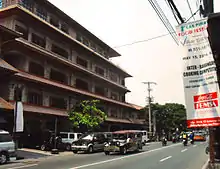Diego Cera Avenue
The Padre Diego Cera Avenue, or simply Diego Cera Avenue, is a major north-south collector road in Las Piñas, southern Metro Manila, Philippines. It is a four-lane undivided arterial running parallel to the Manila–Cavite Expressway to the west from Manuyo Uno at Las Piñas' border with Parañaque in the north to Zapote near the border with Bacoor, Cavite in the south. It is a continuation of Elpidio Quirino Avenue from Parañaque and was originally a segment of Calle Real in Las Piñas. The road is a component of the National Route 62 (N62) of the Philippine highway network and Radial Road 2 (R-2) of Manila's arterial road network. It was previously designated as N1 on the old route numbering system.
.svg.png.webp) R-2 | |
|---|---|
| Diego Cera Avenue | |
 Diego Cera Avenue northbound in Ilaya | |
| Former name(s) | Calle Real |
| Part of | |
| Namesake | Diego Cera de la Virgen del Carmen |
| Maintained by | Department of Public Works and Highways - Las Piñas-Muntinlupa District Engineering Office |
| Length | 3 km (2 mi) |
| Location | Las Piñas |
| North end | |
| Major junctions | C-5 Road Extension Naga Road |
| South end | |
The avenue marks the original shoreline of Manila Bay in Las Piñas as it existed during the Spanish colonial period. Prior to the construction of the Coastal Road in 1985, the road served as the highway linking Manila with Cavite and other southern provinces. The Manila Bay shoreline is currently about 400 to 600 meters to the west.
The road is situated in the Las Piñas historical corridor being home to the city's oldest structures such as the Las Piñas Church, the Las Piñas Gabaldon Hall, and the old Las Piñas District Hospital.[1] It was named for Fray Diego Cera de la Virgen del Carmen (1762–1832), the Spanish missionary from Huesca who designed and built the world-famous Bamboo Organ in 1824.[2]
Route description


Diego Cera Avenue begins in barangay Manuyo Uno as a continuation of Elpidio Quirino Avenue south of Villareal Street running parallel to the Manila–Cavite Expressway to the west and Tramo Street to the east. It proceeds due south entering the old downtown barangays of Daniel Fajardo, Ilaya, and Elias Aldana where the old Las Piñas Municipal Hall and Las Piñas Church are located. Upon crossing the Las Piñas River via the Diego Cera Bridge, the avenue enters barangay Pulang Lupa Uno where the old Sarao Motors factory and the Las Piñas General Hospital are located. It intersects with Carlos Garcia Avenue Extension (C-5) and Naga Road before arriving in barangay Zapote. The avenue terminates at Alabang–Zapote Road near the city's boundary with Cavite where it continues as Aguinaldo Highway.
Other notable landmarks along the avenue include the Saint Joseph's Academy, Plaza Quezon, Las Piñas Catholic Cemetery, Maricielo Villas, and Zapote Public Market.
See also
References
- "Las Piñas historical corridor: Soul of the city". Philippine Daily Inquirer. Retrieved 4 April 2015.
- "Bamboo Organ". City Government of Las Piñas. Archived from the original on 28 April 2015. Retrieved 4 April 2015.